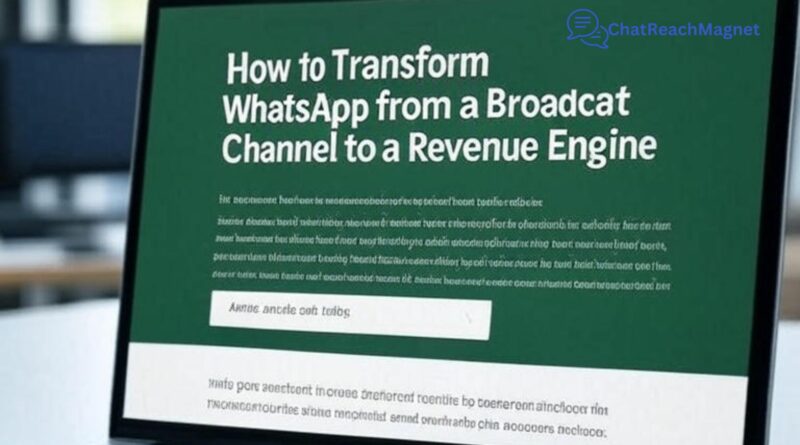How to Transform WhatsApp from a Broadcast Channel to a Revenue Engine
For years, businesses have treated WhatsApp as just another broadcast channel – a convenient platform to send updates, promotions, and announcements. While that approach helps with visibility, it barely scratches the surface of WhatsApp’s true potential.
With over 2.7 billion active users globally (and counting), WhatsApp is no longer just a messenger; it is fast becoming one of the most powerful sales and customer engagement platforms in the digital world.
The question is no longer “Should you use WhatsApp for your business?” but rather, “How do you turn WhatsApp into a revenue engine?”
This article will guide you step by step on transforming WhatsApp from a simple broadcasting tool into a direct sales, engagement, and revenue-generating powerhouse for your business.
Rethinking WhatsApp’s Role in Business

Traditionally, WhatsApp has been seen as a communication channel—a way to send bulk messages, share promotions, or respond to inquiries. But if you only use WhatsApp as a broadcast tool, you are missing out on three critical areas:
- Personalisation: Customers expect brands to talk to them, not at them.
- Engagement: Two-way conversations build trust, which directly drives sales.
- Conversions: WhatsApp offers an intimate space where customers are more likely to take action compared to email or social ads.
Transforming WhatsApp into a revenue engine means integrating it into your sales funnel, treating every message as a potential transaction, and creating systems that drive measurable ROI.
WhatsApp Business & API
The first step is to move away from using personal WhatsApp for business and embrace WhatsApp Business tools:
a) WhatsApp Business App
Designed for small businesses, this free app allows you to:
- Set up a business profile with address, website, and description.
- Create quick replies and automated greeting messages.
- Organise customers with labels (e.g., “New Lead,” “Returning Customer”).
b) WhatsApp Business API
For medium and large enterprises, the API opens the door to scalability and automation, enabling:
- Integration with CRM systems.
- Automated chatbots for FAQs and order tracking.
- Bulk personalised campaigns with templates approved by WhatsApp.
By using these tools, you lay the foundation for structured communication that goes beyond broadcasts and moves into customer nurturing and sales generation.
Leveraging WhatsApp for Sales Funnels
To transform WhatsApp into a revenue driver, think of it as a mini sales funnel:
Lead Generation
- Use Click-to-WhatsApp Ads on Facebook and Instagram.
- Add a WhatsApp button to your website, email signatures, and social bios.
- Offer exclusive deals in exchange for opting in (e.g., “Get a 10% discount when you join our WhatsApp list”).
Lead Nurturing
- Send personalised recommendations based on customer interests.
- Share useful content like tips, tutorials, or product usage guides.
- Segment your audience into groups: new leads, loyal customers, high spenders.
Conversions
- Share time-sensitive offers (“Flash sale: valid for the next 6 hours”).
- Provide product catalogues with direct purchase links.
- Enable In chat payments (available in several countries).
Retention & Upselling
- Send reminders about restocks or subscription renewals.
- Upsell complementary products (“You bought X, would you like Y at 20% off?”).
- Build loyalty programmes accessible via WhatsApp.
By designing your WhatsApp communications to follow the customer journey, you create a frictionless path from awareness to purchase.
Personalisation: The Heart of WhatsApp Selling
Unlike emails that often get buried, WhatsApp messages land directly in the customer’s hand. But this power comes with responsibility. Customers expect human-like, personalised communication.
Practical Ways to Personalise:
- Use customer names in messages.
- Segment by interest: A fitness brand can create groups like “Weight Loss,” “Muscle Gain,” or “Yoga.”
- Behavioural triggers: Send abandoned cart reminders or follow-ups after a purchase.
- Interactive messages: Use polls, buttons, and quick reply options for engagement.
When customers feel messages are tailored specifically for them, open rates, click-through rates, and conversions skyrocket.
Automation and Chatbots: Scaling Without Losing the Human Touch
One challenge with WhatsApp is scale. As your customer base grows, manual replies become impossible. That is where automation and chatbots
step in.
Benefits of WhatsApp Chatbots:
- Answer FAQs instantly (delivery times, returns, store hours).
- Provide 24/7 support.
- Qualify leads by asking pre-set questions.
- Route customers to human agents when necessary.
However, the goal is not to sound robotic. The best-performing chatbots balance automation with human escalation, ensuring customers feel heard and valued.
Integrating Payments into WhatsApp
In markets like India, Brazil, and Singapore, WhatsApp Pay already allows customers to make payments directly within chats. Even in regions where WhatsApp Pay is not yet available, businesses can integrate third-party payment links.
This feature transforms WhatsApp into a direct sales channel where customers can:
- Browse products.
- Ask questions.
- Pay instantly.
Reducing friction in the buying process leads to higher conversions and repeat purchases.
Driving Revenue with WhatsApp Campaigns
To shift from broadcasting to revenue generation, your campaigns must focus on value-driven selling.
Campaign Ideas That Drive Sales:
- Exclusive Offers: “WhatsApp-only” discount codes.
- Product Launches: Early access for subscribers.
- Limited-Time Sales: Flash deals with countdown timers.
- Customer Stories: Share testimonials and encourage social proof.
- Seasonal Campaigns: Holiday promotions, back-to-school deals, or festive bundles.
The key is to create urgency, exclusivity, and engagement, while ensuring messages remain helpful, not intrusive.
Tracking Performance: From Chats to Revenue
Just like email marketing or ads, you must measure ROI on WhatsApp. Some key metrics include:
- Open Rates: Almost always higher than email, often 80–98%.
- Click-Through Rates (CTR): Links in WhatsApp messages typically outperform traditional channels.
- Conversion Rates: Track sales directly generated from WhatsApp campaigns.
- Customer Lifetime Value (CLV): Measure how WhatsApp engagement increases repeat purchases.
With WhatsApp Business API integrations, these metrics can be tracked seamlessly, proving its role as a revenue engine.
Best Practices for Long-Term Success
To ensure WhatsApp remains a sustainable revenue channel, follow these principles:
- Get customer consent before sending messages (avoid spam).
- Respect frequency: Do not overwhelm users with too many updates.
- Provide value in every message: Educational content, offers, or useful reminders.
- Maintain professionalism: Use business profiles, branded catalogues, and quick replies.
- Stay compliant: Follow WhatsApp’s Commerce and Business Policy to avoid penalties.
Real-Life Examples of WhatsApp as a Revenue Driver
- Nike uses WhatsApp to give customers personalised recommendations, driving direct sales.
- Sephora enables customers to book beauty consultations and buy products within WhatsApp.
- Local SMEs like restaurants use WhatsApp for reservations, menu browsing, and payment collection.
Whether you are a global brand or a small business, WhatsApp can be your most profitable channel when integrated properly.
Conclusion: From Broadcasts to Business Growth
WhatsApp is no longer just a broadcasting platform; it is a revenue-generating engine waiting to be tapped. By shifting from one-way announcements to two-way, personalised, and transaction-driven engagement, businesses can unlock unprecedented growth.
The secret lies in treating WhatsApp as more than a messenger. When combined with automation, sales funnels, payment integration, and performance tracking, WhatsApp becomes a direct line to sales, loyalty, and long-term customer relationships.If you are still using WhatsApp just to send updates, now is the time to evolve. With the right strategy, your next customer interaction on WhatsApp could be more than a conversation—it could be a conversion.

